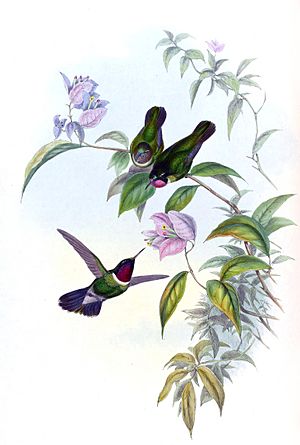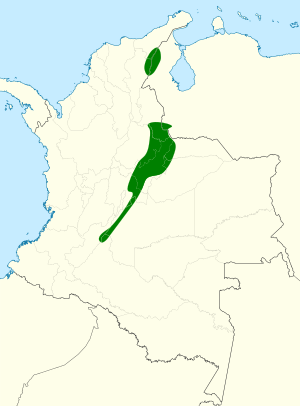Longuemare's sunangel facts for kids
Quick facts for kids Longuemare's sunangel |
|
|---|---|
 |
|
| Conservation status | |
| Scientific classification | |
 |
|
| Synonyms | |
|
The Longuemare's sunangel (Heliangelus clarisse) is a beautiful type of hummingbird. It belongs to a group of hummingbirds called "coquettes." These tiny birds are found in the mountain areas of Colombia and Venezuela.
Contents
About This Bird
Scientists who study birds sometimes have different ideas about how to group them. The Longuemare's sunangel (Heliangelus clarisse) is usually seen as its own unique species. However, some experts think it might be a subspecies of another bird called the amethyst-throated sunangel. There are two or three slightly different types, or subspecies, of the Longuemare's sunangel.
What It Looks Like
The Longuemare's sunangel is a small bird, about 9 to 10 centimeters (3.5 to 4 inches) long. It weighs only about 5 to 6 grams (0.18 to 0.21 ounces), which is less than a pencil! It has a short, straight, black beak.
The adult male of the most common type, H. c. clarisse, has a shiny blue-green band just above its beak. Its head is dark, and its upper body is a dark, shiny green. It has a bright, rosy, shimmering patch on its throat and upper chest, called a gorget. Below this, there's a white band. The rest of its underside is a dull yellowish-brown with round green spots. Its inner tail feathers are dark green, and the outer ones are blackish, sometimes with light tips.
Female birds have dull brown throat feathers with hints of red or bronze-green. Their bellies have fewer spots than the males'. Young birds look similar to the adult females.
Other types of this bird have slightly different colors. For example, the male H. c. violiceps has a very blue band above its beak and a purple throat patch. The male H. c. verdiscutus has a bright green band above its beak and a deep purple head.
Where It Lives
The main type of Longuemare's sunangel, H. c. clarisse, lives in the eastern mountains of Colombia and nearby western Venezuela. Another type, H. c. violiceps, is found further north, in a mountain range called Serranía del Perijá, which is on the border between Colombia and Venezuela. The third type, H. c. verdiscutus, lives only in the Tamá Massif, another mountain area on the Colombia-Venezuela border.
These hummingbirds mostly live at the edges of wet cloudforests and "elfin forests." These are forests where the trees are often small and twisted due to high altitude and mist. They can also be found in more open areas like fields with scattered bushes and trees, open woodlands, and overgrown valleys. They live at high elevations, from about 1,800 to 3,600 meters (5,900 to 11,800 feet) above sea level.
Behavior
Movement
The Longuemare's sunangel is a sedentary bird. This means it usually stays in the same area and does not migrate.
Feeding
This hummingbird mainly eats nectar from flowers. It also catches insects to add to its diet. It often defends areas with many nectar-rich flowers from other birds. It usually feeds up to 6 meters (20 feet) high, often near streams. It catches insects by flying out from a perch, grabbing the insect in the air, and then returning to its perch. This is called "hawking."
Reproduction
The breeding season for the Longuemare's sunangel lasts at least from May to August. The female builds a nest using moss and thin plant materials. The nest is usually hung under a large leaf or another structure that protects it from the weather. The female lays two eggs and takes care of them herself. We don't know exactly how long it takes for the eggs to hatch or for the young birds to leave the nest.
Vocalization
The call of the Longuemare's sunangel is described as a repeated, dry sound that goes up in pitch, like "tsik" or "tsit."
Conservation Status
The IUCN (International Union for Conservation of Nature) has listed the Longuemare's sunangel as a species of "Least Concern." This means that it is not currently considered to be in danger of extinction. Its population size is not fully known, but it is believed to be stable. It is thought to be a fairly common bird, and there are no known major threats to its survival right now.
See also
 In Spanish: Heliangelus clarisse para niños
In Spanish: Heliangelus clarisse para niños


